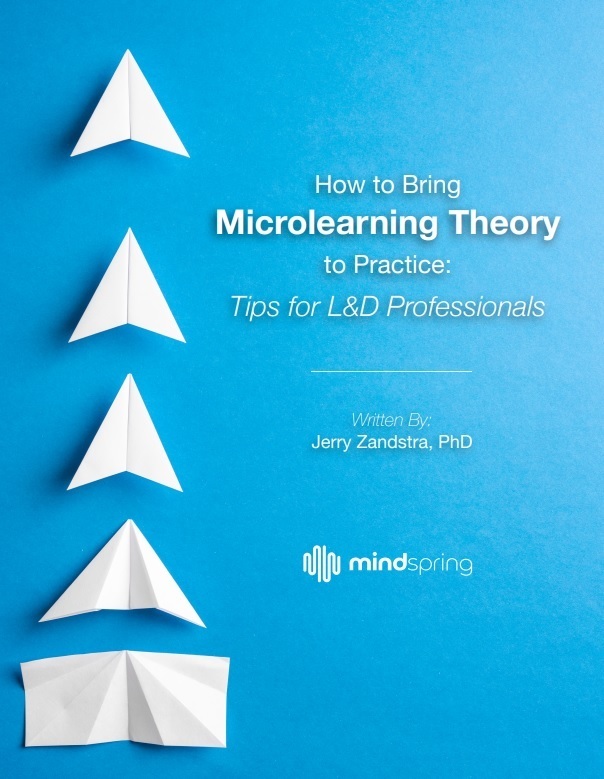What Is Microlearning And Why Does It Deliver Major Results?
Microlearning has been around, in some sense, since humans first taught one another something new. Most of us had the childhood experience of having someone older and more skilled or knowledgeable standing next to us while we tried to learn a new skill and then saying, “Not like that—like this,” and then proceeded to tell us just what we needed to know, at just the right moment.

While the concept isn’t new, its delivery and accessibility are changing the landscape of learning, from university classrooms to sales teams to skilled tradespeople working on an assembly line. Some of us still remember the first time we searched for a how-to video on YouTube and found an entire universe that held the possibility of making us capable of something unknown to us previously. How wonderful to learn in minutes how to reset a car’s oil-change light, after searching the owner’s manual to no avail. We’re suddenly aware that we’re capable of a great many things, with the right information, at just the right time.
Wikipedia, while not as useful for quickly acquiring a skill, is a wonderful source of knowledge just when we need it. Open to all. Free to all. Contributions by all. It’s rare to search for something and not find it there. Certainly, some information is wrong, and some of the connections between pieces of information are misleading, which is why some college students learn, painfully, that quoting Wikipedia isn’t acceptable in a research paper. The worlds of corporate learning and higher education require more precision and control.
Microlearning isn’t limited to one specific setting. There are potentially thousands of microlearning opportunities in one-on-one training, the classroom or training room, and dozens of other settings. This article’s focus is on microlearning in the digital setting, where it can be delivered in a myriad of ways: animations, videos, more-traditional eLearning modules, interactive pdfs, infographics, podcasts, and more.
Key Characteristics To Microlearning
What does and what doesn’t qualify as microlearning is a moving target. The science, specifically applied to digital learning, is fairly new, as are the techniques. The technological changes that constantly occur make things possible that were impossible only a few months prior. But there are some key characteristics to microlearning, and we encourage you to look at them as a whole rather than as single pieces. Together, these characteristics paint a picture of microlearning in a way we hope will be useful to you and your organization.
1. Small Or Short
Short, of course, is a relative term. An hour-long presentation wouldn’t quality as microlearning. In most instances, neither would a twenty-minute eLearning module. But there’s no magic number for what should be considered microlearning. As with all learning, the length should be attuned to the learner’s needs and the organization’s goals. A good rule of thumb is that microlearning should be as short as possible without sacrificing quality or objectives. When done best, microlearning is short bursts of learning that’s useful to introduce something, reinforce something, or remind of something.
2. Accessibility
Microlearning should be right where learners need it when they need it. This may mean highly mobile. It could also mean a tablet near a workstation, from which a team member can, within a few seconds, pull the information desired. It certainly doesn’t mean making a mental note to learn something later, when the information becomes available, or waiting until the next class to learn more. The concept of on-demand is an important one for microlearning.
3. Narrow
The topics contained in a microlearning asset should be narrow rather than broad. They’re better pointed at a very specific part of a process and not comprising a more generic overview. In many instances, a microlearning asset will answer a single question or a very limited number of questions.
4. Pragmatic
Microlearning most often points to an immediate and highly practical topic. “How do I . . .” is the most common starter. To put it another way, microlearning often seeks to bring about an immediate change.
5. Stand-Alone
A microlearning asset is frequently a stand-alone piece that answers a specific question in a process or a frequently asked question. But it’s also possible to design microlearning in a series, in which smaller bites of information are released over time—more of a slow-release. Serious Instructional Design is required, as those creating the learning must have a solid understanding of the learners’ needs prior to the learners expressing those needs.
6. Performance-Based
There are instances when a learner demonstrates no mastery of the concept or behavior at hand. This doesn’t mean the learner didn’t understand or grasp the entire course. Most likely, it means that the learner has forgotten or misunderstood a subset of a larger learning experience. Microlearning can be useful as a gracious reminder, giving learners an additional opportunity to gain mastery.
7. Push And Pull
With microlearning, learning leaders can push bite-sized modules to learners. We’ve seen this used effectively at the beginning or end of a day—a daily, digestible piece of information that’s informative and, done well, interesting (and, dare we say, entertaining?). Of course, learners call also pull the content they need, at the moment they need it. Onboarding with short microlearning modules over time will certainly be more effective than the massive data dump most new employees experience in their first week or two on a job.
8. Culture Of Learning
When earners know that they can easily and quickly find the information they need without a seemingly endless search, they’ll be more likely to make use of the learning content available to them. Learning a little at a time often leads to a desire to learn a lot more. On occasion, learners will seek a deeper dive into a topic that fascinates them or is especially helpful in their daily work.
What Microlearning Is Not
As important as it is to carefully consider microlearning’s chief characteristics, it’s also helpful to say a few words about what microlearning isn’t. It’s not merely chunking existing learning assets into smaller pieces. Microlearning is a very specific kind of learning, and one needs to give serious thought to objectives, length, focus, subject, delivery, and accessibility. In other words, the learning experience needs to be specifically designed for microlearning.
Finally, microlearning isn’t necessarily low-effort learning. Even short bursts of focused learning can be intense and require deep and serious thought.
Final Thoughts
The technology available and the long history of microlearning can be combined in powerful ways to bring about significant learning opportunities and organizational change. Those willing to commit to the work and the design thinking required will find that their efforts are well rewarded.
If you want to discover more about microlearning, download the eBook How To Bring Microlearning Theory To Practice: Tips For L&D Professionals. Get to discover all the enticing microlearning tips for L&D professionals. Also, join the webinar to discover how microlearning impacted employees' behavior and transformed organizational culture.









